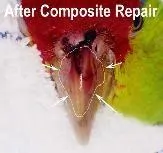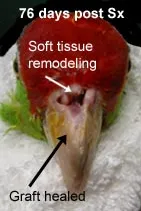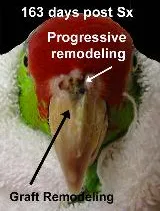



The "beak" of a bird is made up two main parts: The rhinotheca (upper beak) and the gnathotheca (lower beak). These two parts articulate under a more complex joint mechanism than the human jaw and therefore can have more potential problems. These include
1. Juvenile growth deformities - These deformities are relatively easy to fix if done VERY EARLY! The older the bird gets the more difficult and expensive the repair becomes.
2. Fractures of the beak structure - Treated with a combination of orthopedic equipment and dental bonding/composite agents. The use of exothermic acrylics is NOT recommended.
3. Dislocation of the rhinotheca or gnathotheca - Can often be corrected under anesthesia with temporary modification of the diet.
4. Avulsions - Tearing of the keratin surface off of its bone foundation. Prognosis is generally very guarded in these cases, but some can be repaired if performed quickly, generally within 24 hours from the time of injury.
The key to most of these problems is that they be dealt with as quickly as possible. Time is the enemy with beak pathology. The beak has a blood supply that must be preserved and a boney base that must be nourished or it cannot support new beak growth (repair).
In 1989, Dr. Robert Clipsham wrote a medical paper on the diversity of beak pathology and how some could be repaired versus the outcome of lifelong trimming, disfigurement and sometimes death. Dr. Nemetz working independently on similar problems presented his and Dr. Clipsham's data to his father, a dentist teaching at University of Southern California (USC) dental school, to receive advice regarding state of the art technology available in human dentistry that could further advance the work done so far in beak reconstruction.
Since that time, with the help of several human dentists and generous manufacturers, The BIRD Clinic has developed many techniques for beak pathologic conditions and has helped many birds back to a normal life.
Dr. Nemetz continues to explore the most current human dental technology. He has attended the California Dental Association (CDA) annual meeting every year since 1991. The latest bonding and composite technologies, along with new instrumentation, are showcased. Dr. Nemetz has adapted many of these products to avian medicine to further increase the chance of success in these cases and save the bird's ability to eat and function normally.


